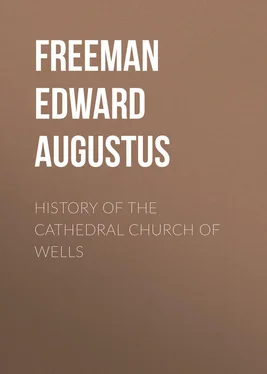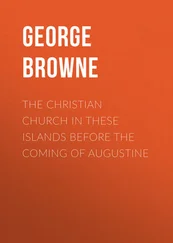Edward Freeman - History of the Cathedral Church of Wells
Здесь есть возможность читать онлайн «Edward Freeman - History of the Cathedral Church of Wells» — ознакомительный отрывок электронной книги совершенно бесплатно, а после прочтения отрывка купить полную версию. В некоторых случаях можно слушать аудио, скачать через торрент в формате fb2 и присутствует краткое содержание. Жанр: foreign_antique, foreign_prose, на английском языке. Описание произведения, (предисловие) а так же отзывы посетителей доступны на портале библиотеки ЛибКат.
- Название:History of the Cathedral Church of Wells
- Автор:
- Жанр:
- Год:неизвестен
- ISBN:нет данных
- Рейтинг книги:4 / 5. Голосов: 1
-
Избранное:Добавить в избранное
- Отзывы:
-
Ваша оценка:
- 80
- 1
- 2
- 3
- 4
- 5
History of the Cathedral Church of Wells: краткое содержание, описание и аннотация
Предлагаем к чтению аннотацию, описание, краткое содержание или предисловие (зависит от того, что написал сам автор книги «History of the Cathedral Church of Wells»). Если вы не нашли необходимую информацию о книге — напишите в комментариях, мы постараемся отыскать её.
History of the Cathedral Church of Wells — читать онлайн ознакомительный отрывок
Ниже представлен текст книги, разбитый по страницам. Система сохранения места последней прочитанной страницы, позволяет с удобством читать онлайн бесплатно книгу «History of the Cathedral Church of Wells», без необходимости каждый раз заново искать на чём Вы остановились. Поставьте закладку, и сможете в любой момент перейти на страницу, на которой закончили чтение.
Интервал:
Закладка:
8
On this whole matter, see Anglia Sacra, i. 553, and the Historiola de Primordiis Episcopatûs Somersetensis in Hunter's Ecclesiastical Documents, p. 10. The alleged charter of Cynewulf will be found in Kemble's Codex Diplomaticus, i. 141.
9
Ceawlin conquered to the Axe in 577; Cenwealh to the Parret in 658; Ine, as we see, as far as Taunton. On Ceawlin see Dr. Guest in the Archæological Journal, xix. 193.
10
That is, the modern shires of Monmouth and Glamorgan.
11
This is shown in various passages of the Laws of Ine. See Thorpe's Laws and Institutes, i. 119, 131, 147, 149.
12
See the whole history of the early church of Glastonbury in the first chapter of Professor Willis' Architectural History of Glastonbury Abbey.
13
See Willis' Architectural History of Canterbury, p. 20; ditto Winchester, p. 34.
14
It is not said in so many words that the church of Dunstan was of stone, but it is plain that it was so, both because the "lignea basilica" or wooden church is distinguished from it, and because Osbern the biographer of Dunstan (Anglia Sacra, ii. 100) speaks of him as laying the foundations, which could hardly be said of a wooden church.
15
See the account of the Canons of Waltham in the book De Inventione, and those of Rheims in Richer, iii. 24.
16
I have discussed this in full in my History of the Norman Conquest, ii. 571, Ed. 2.
17
When a Bishop is to be elected by the Chapter, two quite distinct documents are sent; there is first the congé d'élire , which recognizes the undoubted right of the Chapter to elect and gives them full leave to elect, only with a little good advice as to the sort of person to be chosen. With this, as a kind of after-thought, comes the letter missive or letter recommendatory , recommending a particular person for election.
18
The names of the early Bishops, of whom but little is recorded, will be found in the Canon of Wells, Anglia Sacra, i. 556, and Godwin's Catalogue of English Bishops, 290.
19
He was "natione Saxo," says his successor Gisa in the Historiola de Primordiis Episcopatûs Somersetensis. See Norman Conquest, ii. 583.
20
See Godwin, p. 291.
21
Anglia Sacra, i. 559.
22
See Historiola, 15-18; Mr. J. R. Green in the Transactions of the Somersetshire Archæological and Natural History Society, 1863-4, p. 148; and Norman Conquest, ii. 674.
23
For examples see Norman Conquest, ii. 549.
24
See the writ, the only writ of Harold's which is preserved, in Kemble's Codex Diplomaticus, iv. 305.
25
After mentioning Harold's promise, Gisa (Historiola, p. 18) adds, "præoccupante autem illum judicio divinæ ultionis," and goes on to speak of Harold's two battles and his death.
26
Historiola, p. 19, "publice vivere et inhoneste mendicare necessariorum inopia antea coegerat."
27
For the story of Hermann, see Norman Conquest, ii. 401.
28
On these places see Historiola, pp. 18, 19. But it is as well to say that the well-known charter of Eadward to Gisa, printed in Cod. Dipl. iv. 162, is undoubtedly spurious, though it is useful as giving the names of places in the neighbourhood, in older, though not always their oldest, forms.
29
The rule of Chrodegang will be found at length in D'Achery's Spicilegium, i. 565; and see Norman Conquest, ii. 84.
30
This was about 969. Adalbero's changes are described at length by Richer, iii. 24, in Pertz's smaller collection.
31
See Norman Conquest, ii. 84.
32
In Domesday Book, pp. 89-89 b , the land of the canons is put under that of the Bishop; "Canonici Sancti Andreæ tenent de Episcopo." This is much the same with the Canons of Exeter in p. 101 b . In the Exon Domesday, (71)"Isaac præpositus Canonicorum Sancti Andreæ" is mentioned by name.
33
Historiola, 21: "Sepultus est in ecclesiâ quam rexerat, in hemicyclo [a semicircle or round arch] facto in pariete a parte aquilonali prope altare, sicut Duduco prædecessor ejus sepultus est a meridie juxta altare."
34
Will. Malms. Gest. Regg. iii. 300. "Pronunciatum est secundum dicta canonum ut episcopi transeuntes de villis constituerent sedes suas in urbibus diœcesium suarum." This was in 1072, but the change at Wells did not take place just yet.
In his other book, the Gesta Pontificum (144 b ), he says that John "minoris gloriæ putans si in villâ resideret inglorius, transferre thronum in Bathoniam animo intendit."
35
William of Malmesbury, in the place last quoted, says, "Cessit enim Andreas Simoni fratri, frater major minori."
36
See the Chronicles under 577, and note 9.
37
The charters are given in Dugdale's Monasticon, ii. 66, 67. In the second charter of Henry the First he speaks of "Batha ubi frater meus Willielmus et ego constituimus et confirmavimus sedem episcopatûs totius Summersetæ, quæ olim erat apud villam quæ dicitur Wella." The grant of the town which is confirmed in this charter of Henry is made in a charter of William Rufus on the same page.
38
So says William of Malmesbury in the passage last quoted: "Aliquantum dure in monachos agebat, quod essent hebetes et ejus æstimatione barbari."
39
The Historiola mentions the destruction of Gisa's buildings, and the Canon of Wells adds (Anglia Sacra, i. 560), "Fundum in quo prius habitabant sibi et suis successoribus usurpavit, palatiumque suum episcopale ibidem construxit."
40
See Willis' Architectural History of Winchester, 34, 35.
41
Historiola, p. 22. "Canonici foras ejecti coacti sunt cum populo communiter vivere."
42
The story of Hildebert, John, and the Provostship is given both in the Historiola and by the Canon of Wells. Several letters discussing the matter appeared in the Gentleman's Magazine in the year 1864 in the numbers for February, July, August, September, October, November, and December, especially one by Mr. Stubbs in November.
That Hildebert was the brother of Bishop John appears from a charter of Bishop Robert (which I shall have to quote again) in the Monasticon, ii. 293, where Bishop John is called the uncle of Precentor Reginald.
43
This comes afterwards in the Historiola, p. 24.
44
The Canon (p. 560) says, "Licet ipse confractus senio inde pœniteret, tamen ædificia canonicorum destructa minime reparavit, nec fundum eis injuste ablatum restituit." But the Historiola seems to imply at least a purpose of restitution, as its words are, "Pœnitentiâ ductus de sacrilegio perpetrato, resipuit et pœnituit, et pœnitentiam suam scriptam reliquit. Johannes vero Archidiaconus terras quas pater suus obtinuerat per hæreditatem et præposituram canonicorum nihilominus sibi usurpavit."
45
The Charter is printed in the Monasticon, ii. 268.
Читать дальшеИнтервал:
Закладка:
Похожие книги на «History of the Cathedral Church of Wells»
Представляем Вашему вниманию похожие книги на «History of the Cathedral Church of Wells» списком для выбора. Мы отобрали схожую по названию и смыслу литературу в надежде предоставить читателям больше вариантов отыскать новые, интересные, ещё непрочитанные произведения.
Обсуждение, отзывы о книге «History of the Cathedral Church of Wells» и просто собственные мнения читателей. Оставьте ваши комментарии, напишите, что Вы думаете о произведении, его смысле или главных героях. Укажите что конкретно понравилось, а что нет, и почему Вы так считаете.












